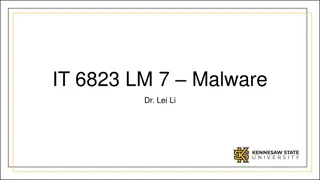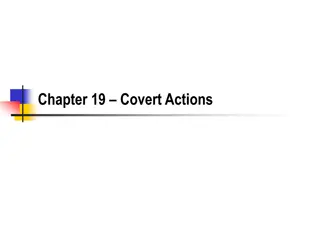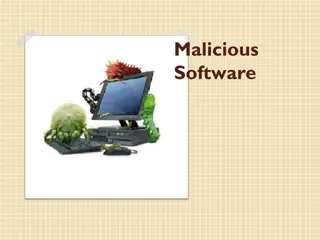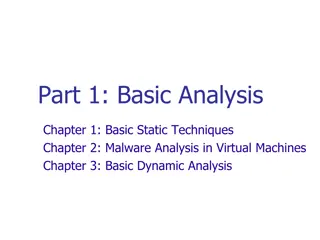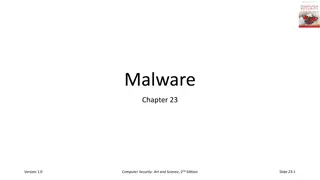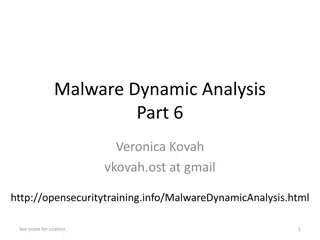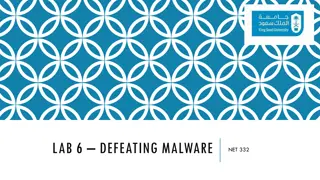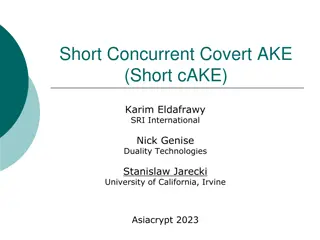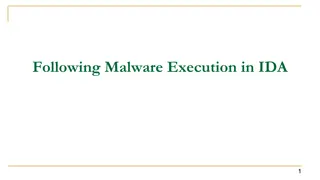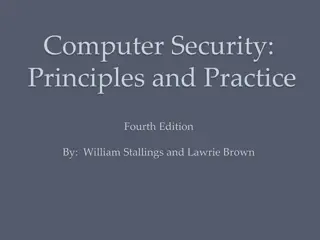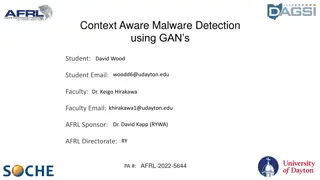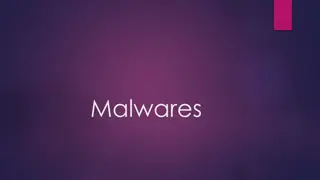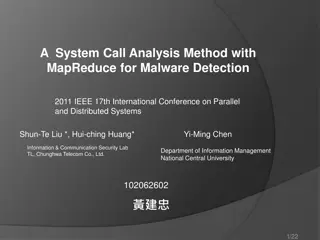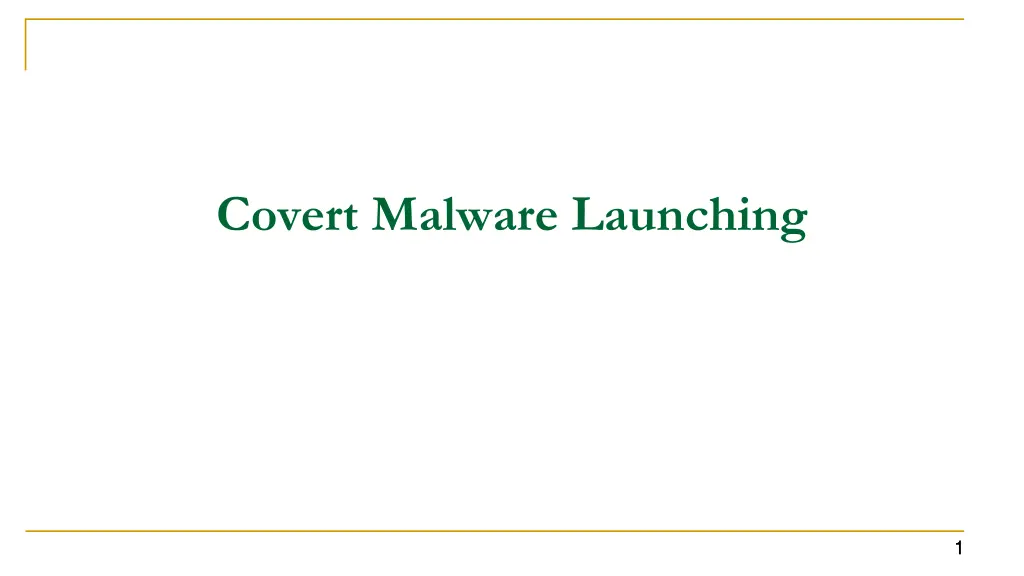
Covert Malware Launching Techniques for Avoiding Detection
Explore covert techniques for launching malware to evade detection, including loader/launcher malware, process injection, and DLL injection. Learn how malware hides from task managers and antivirus programs, and discover common indicators to detect covertly launched malware on live systems.
Uploaded on | 2 Views
Download Presentation

Please find below an Image/Link to download the presentation.
The content on the website is provided AS IS for your information and personal use only. It may not be sold, licensed, or shared on other websites without obtaining consent from the author. If you encounter any issues during the download, it is possible that the publisher has removed the file from their server.
You are allowed to download the files provided on this website for personal or commercial use, subject to the condition that they are used lawfully. All files are the property of their respective owners.
The content on the website is provided AS IS for your information and personal use only. It may not be sold, licensed, or shared on other websites without obtaining consent from the author.
E N D
Presentation Transcript
Covert Malware Launching Techniques for executing malware with the goal of avoiding detection Malware wants to hide from task manager, antivirus, etc. Analysts must be aware of common covert malware launching techniques Be aware of common Windows API call indicators Find covertly launched malware on a live system 2
Loader / Launcher A category of malware that contains a payload to be covertly executed Typically, the payload is obfuscated on disk to hide malicious functionality from static analysis Example: A loader contains an obfuscated PE file as a resource. It loads and deobfuscates the resource, then injects into explorer.exe to give it execution. 3
Process Injection Most popular type of covert malware launching Malware injects code into a legitimate process Typically indicated by VirtualAllocEx and WriteProcessMemory 3 major types: DLL injection, direct injection, process replacement 4
DLL Injection Part 1 Type of process injection where a victim process is forced to load a malicious DLL Step 1: Loader gets a handle to the victim process Takes a snapshot of the running processes and iterates over them Gets the PID of the victim process Obtains handle to the process using its PID Typical API calls: CreateToolHelp32Snapshot, Process32First, Process32Next, OpenProcess 5
DLL Injection Part 2 Step 2: Loader writes name of DLL in victim process s memory VirtualAllocEx given handle to victim process, allocate space for the name of the malicious DLL WriteProcessMemory Writes malicious DLL name to space allocated with VirtualAllocEx 6
DLL Injection Part 3 Step 3: Loader calls CreateRemoteThread with: hProcess = handle to the target process from previous step lpStartAddress = address of LoadLibraryA lpParameter = name of malicious DLL file to be injected This forces the target process to create a new thread and call LoadLibrary on the malicious DLL Executes any code in the malicious DLL s DllMain export Why? 7
Direct Injection Part 1 Injects code directly into victim process More flexible but has some downsides: Often requires a lot of custom code Might accidentally corrupt the process being injected into 8
Direct Injection Part 2 Step 1: Loader writes any needed data to the victim process Allocate memory for data with VirtualAllocEx Write data to victim process with WriteProcessMemory Step 2: Loader writes any needed code to the victim process Allocate memory for code with VirtualAllocEx Write code to victim process with WriteProcessMemory 9
Direct Injection Part 3 Step 3: Loader calls CreateRemoteThread with: hProcess = handle to the target process lpStartAddress = address of injected code lpParameter = address of injected data May need to do more stuff For example, resolving any needed imports at runtime with LoadLibraryA / GetProcAddress 10
Process Replacement Part 1 Overwrites the memory space of a running process with a malicious executable Gives the malware the same privileges as the process being replaced Step 1: Create malicious process in a suspended state Call CreateProcessA on malicious process Pass parameter dwCreationFlags = 0x4 (CREATE_SUSPENDED) The process s main thread is suspended at the entry point 11
Process Replacement Part 2 Step 2: Get a handle to the victim process Step 3: Release memory of a section(s) of the victim process Call ZwUnmapViewOfSection with victim process s handle Step 4: Allocate new memory to the victim process Call VirtualAllocEx to allocate memory for new executable 12
Process Replacement Part 3 Step 5: Write malware sections to victim process space Call WriteProcess memory, often in a loop Step 6: Modify victim thread s context Call SetThreadContext Change thread s entry point to start of the malicious code Step 7: Resume the malicious thread Call ResumeThread 13
Detection using Process Explorer Use the Verify Process to check signed files for modifications Use the strings view to check for different strings in memory than on disk Investigate the lower pane view for unusual DLLs 14
Hooks Users generate events that are sent to the OS The OS sends messages created by these events to threads registered to receive them A Windows hook can intercept these messages and execute code 15
Creates a Windows hook SetWindowsHookEx idHook Specifies type of hook to install lpfn Address of hook procedure hMod Handle to the DLL containing the hook procedure dwThreadId Identifier of the thread to hook. If it is 0, it hooks all threads on the system 16
Hook Injection Part 1 Hook injection: method for loading malware using hooks Can run malicious code whenever a particular message is intercepted Can make sure a specific DLL is loaded into a victim process address space Will discuss an example of how hook injection can be used to load a DLL 17
Hook Injection Part 2 Step 1: Loader gets address of hook procedure Loader calls LoadLibraryA on malicious DLL Loader calls GetProcAddress to get the address of the hook procedure in the malicious DLL Step 2: Obtain identifier of victim thread Get a handle to the victim thread using CreateToolHelp32Snapshot, Thread32First, Thread32Next, OpenThread Call GetThreadId, passing in the victim thread s handle 18
Hook Injection Part 3 Step 3: Loader calls SetWindowsHookEx with: idHook = type of message to hook (typically an uncommon one) lpfn Address of malicious DLL s hook procedure hMod Handle to the malicious DLL dwThreadId = Victim thread s ID Step 4: Loader sends a message with same type as idHook parameter to the victim process This forces the victim process to load the malicious DLL, any code in its DllMain is executed 19


